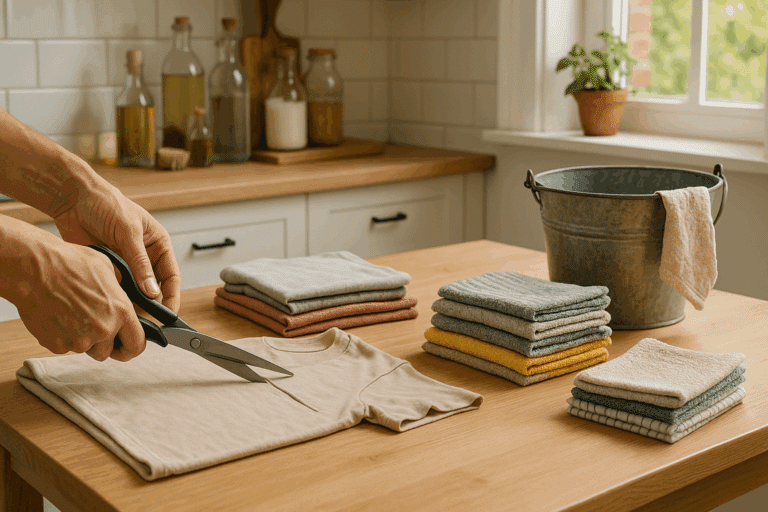One small, yet impactful, step we can take towards this goal is to reconsider the way we do laundry. That’s right—today we’ll be venturing into the world of eco-friendly, DIY laundry detergent.
The concept may seem daunting, but don’t fret. You’re about to discover how easy it is to create an effective, environment-friendly alternative to commercial laundry detergents. Not only will this be gentler on the Earth 🌎, but it can also be a safer option for your family and your wallet. Intrigued? Let’s dive in.
Before we embark on this journey towards a “greener clean,” it’s essential to understand why it’s important. Commercial laundry detergents are often packed with chemicals—some of which are harmful to our health and the environment. These substances may cause allergic reactions, irritate our skin and eyes, and when washed away, they can pollute waterways, harm aquatic life, and disrupt ecosystems. 😢
So, what’s the alternative? The answer is DIY eco laundry detergent, a concoction that is easy to create, highly effective, and much less damaging to our planet. But before you dismiss this as a trendy gimmick, let me assure you—it’s not. It’s a step forward in taking control of our environmental footprint and making more informed choices about what we use in our homes.
The Main Ingredients in DIY Eco Laundry Detergent
Our DIY eco laundry detergent recipe is straightforward and requires only three essential ingredients, which you probably already have at home. The benefits of each of these ingredients are well-documented and crucial to the effectiveness of our homemade detergent. Moreover, they are readily available and won’t break the bank.
These key ingredients are:
1. Washing Soda: A powerful cleaner and water softener.
2. Borax: Enhances the cleaning power and helps to remove stains.
3. Soap: The base of our DIY detergent, responsible for tackling dirt and grime.
We’ll dive deeper into these ingredients, their properties, and their roles in our homemade laundry detergent in the main section of our blog post.
Three Easy Steps to a Greener Clean
Now that you’re familiar with the ‘why’ and the ‘what,’ it’s time to get to the ‘how.’ Our DIY eco laundry detergent can be made in three simple steps, transforming your laundry routine into a more sustainable practice. 👏
We’ll walk you through each step, explaining the process in detail, and offering tips to ensure you get the best results. And the best part? Once you’ve made your batch, it’ll last you for months.
Our journey to a cleaner and greener world starts at home. So, let’s roll up our sleeves and start making a difference—one load of laundry at a time. 💚
Stay tuned as we delve deeper into this topic, unpack the science behind DIY eco laundry detergent, and provide a step-by-step guide to help you on your way to a greener clean.
Let’s embrace a sustainable lifestyle, one DIY eco project at a time. After all, every step towards a cleaner, greener world counts. Are you ready to take yours?
Why Go Green? The Importance of Eco-friendly Laundry Detergents
As we continue to witness the impacts of climate change, it is increasingly important to evaluate our daily habits and make necessary adjustments to reduce our environmental footprint. One such routine that often goes unexamined is our laundry practices. The detergents we use, many of which are petroleum-based, contribute to water pollution due to their non-biodegradable nature. They contain harmful chemicals that not only have adverse effects on aquatic life but can also be harmful to humans.
Therefore, the use of eco-friendly laundry detergents is not just a trend; it’s a necessity. These green alternatives are made from plant-based materials, free from harmful toxins, biodegradable, and often come in recyclable packaging. Not only are they beneficial to the environment, but they’re also gentle on your clothes and skin.
But why buy when you can DIY? Making your eco-friendly laundry detergent at home is a simple and cost-effective way to ensure you’re using a product that’s safe for you, your clothes, and the environment. Here’s how to do it in three easy steps.
DIY Eco Laundry Detergent: Your Three-Step Guide
Before we get into the steps, let’s first discuss the ingredients you’ll need. The main components of a DIY eco laundry detergent are washing soda, Borax, and a bar of eco-friendly soap. These can be easily found in most grocery stores or online. Now, let’s get into the three-step process.
Step 1: Grating the Soap
The first step in creating your DIY eco laundry detergent involves grating the bar of eco-friendly soap. You can do this using a regular kitchen grater. This process can be a bit tedious, but it’s crucial as it ensures the soap will dissolve easily during washing. If you want to make this step easier, you can chop the soap into chunks and pulse it in a food processor until it’s finely ground.
Step 2: Mixing the Ingredients
Once you have your soap grated, the next step is to mix it with the washing soda and Borax. These ingredients work together to clean your clothes, remove stains, and brighten your fabrics. The typical ratio for this mix is 1 bar of soap, 1 cup of washing soda, and 1 cup of Borax. Mix these ingredients thoroughly in a large bowl.
Step 3: Storing Your Detergent
After you’ve mixed your ingredients together, your DIY eco laundry detergent is ready to use! Store it in an airtight container, and you’re good to go. Use 1-2 tablespoons per load, depending on the size and dirtiness of the laundry.
For a visual guide on how to create your DIY eco laundry detergent, check out this informative video from the YouTube channel “Going Zero Waste”: “DIY Zero Waste Laundry Detergent.”
DIY vs. Store-Bought Eco Detergents: A Comparative Analysis
Now that we’ve explored how to make your own eco-friendly laundry detergent, let’s see how it stacks up against store-bought alternatives.
| Criteria | DIY Eco Detergent | Store-Bought Eco Detergent |
|---|---|---|
| Cost | Usually cheaper, depending on the cost of individual ingredients. | Can be more expensive than regular detergents. |
| Ingredients | Ingredients are known and controlled by the user. | Ingredients are pre-determined, and some brands may contain hidden, non-eco-friendly components. |
| Effort | Requires some effort and time to make. | No effort needed, ready to use. |
While both DIY and store-bought eco detergents have their pros and cons, the choice ultimately depends on your personal preferences, budget, and commitment to sustainable practices. If you decide to go the DIY route, remember, it’s a small effort for a greener clean!
Conclusion
In conclusion, it is clear that the advancements in technology and engineering have brought about a revolution in our daily lives. From the microprocessor that powers your personal computer, to the high-speed data networks that connect us across continents, the role of IT and engineering cannot be underestimated.
Throughout this article, we’ve explored the various intricacies of technology and engineering, delving into the specifics of how these marvels of human intellect work. We’ve explained the functioning of computers, the fundamentals of software development, and the core principles of data networks. In each section, we’ve aimed to break down complex technical jargon into comprehensible information, so you can understand the ‘why’ behind the ‘what’.
First, we examined how microprocessors, the ‘brain’ of any computer, work. From their architecture to their role in data processing, we’ve tried to present a holistic view of these tiny but powerful devices.
Then we moved on to the world of software development, exploring the myriad technologies and methodologies employed by engineers to build the applications that run our world. We discussed various programming languages, development frameworks, and project management techniques, giving you a glimpse into the world of a software engineer.
Finally, we dived into the realm of data networks, discussing how data packets are transmitted across the globe at lightning speed. We also looked at the role of various network devices and protocols in ensuring smooth and secure data transmission.
The goal of this article was not just to inform, but to inspire. To make you marvel at the wonders of technology and spark your curiosity to learn more. If you found the content insightful, don’t hesitate to share it with others who might benefit from it. Use the share buttons below to spread the knowledge. And if you have any questions or insights to share, feel free to leave a comment. 🗨️
Moreover, if you’re intrigued by any of the topics covered and want to delve deeper, we’ve provided links to reliable sources for further research. Check them out to enhance your understanding and satiate your curiosity.
Remember, knowledge is power. The more we know, the better we can use technology to our advantage and contribute to the advancement of our society.
It’s an exciting time to be alive, with technology evolving at a rapid pace. Let’s embrace it, learn from it, and grow with it. And as always, keep exploring, keep learning, and keep sharing. 💡
Learn more about microprocessors
Explore the world of software development
Delve into data networks
So, until next time, stay curious and stay inspired. 🚀
[i]References[/i]
1. Intel Museum – Story of the Intel 4004
2. Oracle Technologies – Java Platform
3. Cisco – What is a network?



